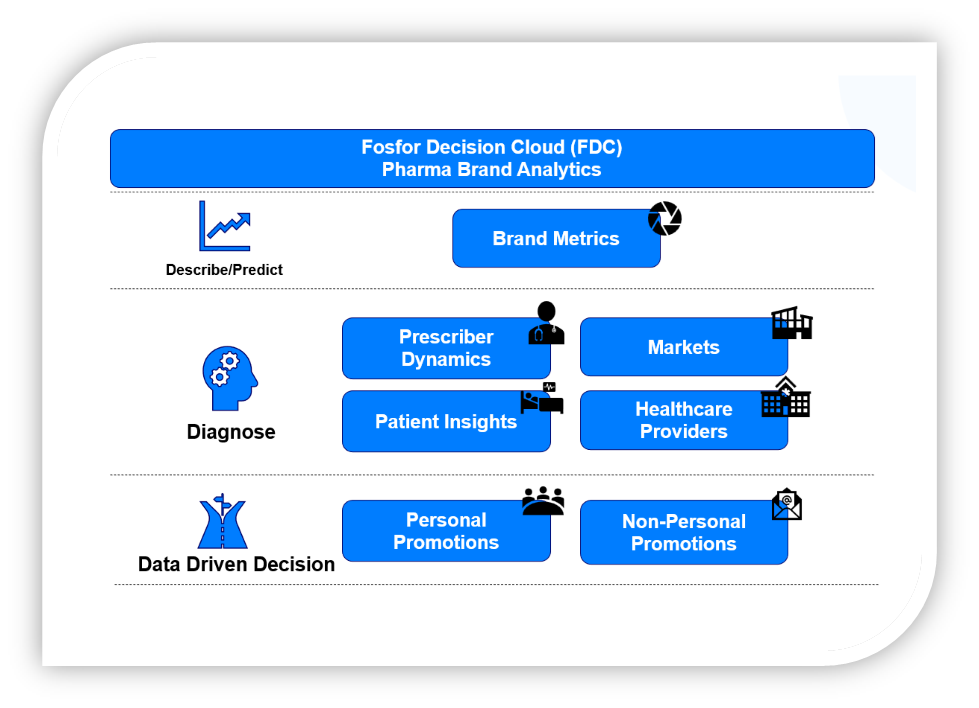 Reading Time: 4 minutes
Reading Time: 4 minutesIntroduction
In the pharmaceutical domain, where innovation intersects with healthcare, understanding brand performance is not just analyzing sales numbers but also a blend of market insights, patient insights, and forward-looking strategies. As a pharmaceutical brand manager, navigating this challenge requires a keen eye for detail and a deep understanding of key concepts. In this article, we will discuss the significance of brand analytics and how they empower brand managers to achieve brand objectives.
Understanding key terminologies
- Total prescriptions (TRx) represent the cumulative number of prescriptions written for a specific pharmaceutical product within a defined period – this is measured monthly or quarterly. This metric serves as a fundamental indicator of demand and product utilization.
- Repeat prescriptions refer to prescriptions for a brand that are written for patients who have previously been prescribed the drug within a specified timeframe. The metric signifies patient retention, treatment adherence, and brand loyalty contributing to the long-term success of the brand.
- New to brand prescriptions (NBRx) metric measures the prescriptions for patients who are new to the brand. NBRx provides insights into the brand’s ability to attract patients, brand share of switchers and expansion potential.
- New prescriptions denote prescriptions for a brand that are provided to patients who have not previously been prescribed the drug. This reflects the brand’s ability to capture new patients indicating potential for growth.
Why brand analytics matter?
At a time when there is an abundance of data, harnessing the power of analytics is principal for steering informed decision-making. Advanced analytical techniques, such as predictive modeling, machine learning, and data visualization, empower brand managers to extract actionable insights from complex datasets.
- Data-driven decision making: Brand analytics provide insights unearthed from data, enabling brand managers to take data-driven and informed decisions citing market trends, prescriber behavior, patient insights, and preferences. They can leverage analytics to guide strategic initiatives.
- Understanding market dynamics: Brand managers gain a deeper understanding of market dynamics including TRx, and new and repeat prescriptions- NBRx. Analyzing trends of TRx enables brand managers to identify growth opportunities and assess the impact of campaigns. Monitoring repeat prescriptions allows brand managers to evaluate patient satisfaction and strengthen brand loyalty initiatives. Tracking NBRx metrics enables brand managers to identify the drivers of brand switching and effectiveness of promotional activities.
- Competitive advantage: Brand analytics provides a competitive advantage by providing a peek into market trends, identifying emerging opportunities and patient behavior to stay ahead in the market.
Who are we solving it for?
Several personas / stakeholders consume brand analytics to take informed, data-driven decisions and drive robust business strategies. Some of the personas are:
- Sales teams: Sales representatives, sales managers and sales operations team depend on brand analytics to assess current market, prioritize targets, and identify territories. Sales teams use analytics to generate insights on key prescribers, track brand sales, and tailor engagement strategies.
- Marketing teams: Includes marketing directors and analysts to track effectiveness of marketing campaigns, promotional activities, and sales initiatives.
- Brand Managers: They are responsible for executing strategies for pharmaceutical products. They bank on brand analytics to understand market dynamics, evaluate brand performance, and maximize brand growth and profitability.
- Healthcare Providers (HCPs): Brand analytics caters to the needs of healthcare providers by providing insights into prescriptions, treatment patterns, and patient outcomes.
- C-Suite Executives: Executive leadership including CMOs and CFOs depend on brand analytics to monitor overall business performance and track key performance indicators (KPI’s).
How are we solving it?
At Fosfor, we have built industry agnostic solutions to empower businesses to arrive at decisions across their organization, along the entire data/business journey. The solve for pharmaceutical brand analytics will encompass analyzing the data from various third-party datasets and in-house datasets to analyze market insights, patient insights, and prescriber dynamics, and perform predictive analytics to take decisions and curate strategies to create profitable and sustainable brands as referenced in Figure 1.

The FDC empowers decision makers to organize data, build impactful AI applications, and explore curiosity to uncover new insights and conduct outcome-focused business decisions in real-time. The FDC covers the entire data-to-decisions spectrum by integrating data and models to simplify analysis, drive performance, and create sustainable growth by providing a unified data journey. Figure 2 illustrates what constitutes the FDC.

The Decision Designer of the FDC, allows business users to ask questions about data in natural language and receive insights through natural language generated narratives and smart visualization. This AI-powered decision intelligence product is designed to streamline and enhance the process of deriving insights from complex data landscapes.
To transform the data-to-decisions journey even further, the FDC offers the Fosfor AI. Fosfor AI helps code, build data and ML pipelines, and conduct business analysis faster. It enhances every stage in the data-to-decisions journey. With Fosfor AI, you have a partner which transforms the way you work allowing you to focus on your business and not worry about the data.
Conclusion
Pharmaceutical brand performance analysis goes above conventional sales performance indicators, involving complicated factors that guide brand success. By decoding key terms and leveraging analytics, brand managers can traverse the difficulties of the pharmaceutical domain with trustworthy data driven decisions, ultimately driving sustained growth.








